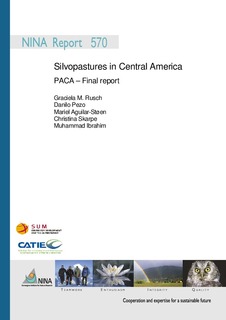Silvopastures in Central America. PACA – Final report
Research report

Åpne
Permanent lenke
http://hdl.handle.net/11250/2594575Utgivelsesdato
2010Metadata
Vis full innførselSamlinger
- NINA Rapport/NINA Report [2341]
- Publikasjoner fra CRIStin - NINA [2364]
Sammendrag
Rusch, G. M., Pezo, D., Aguilar-Støen, M., Skarpe, C. & Ibrahim, M. 2010. Silvopastures in Central America: PACA – Final report. – NINA Report 570. 50 pp.
Silvopastoralism constitutes the predominant feature of the livestock production landscapes in Central America. It consists of an agroforestry practice that integrates trees with forage and livestock production. The dominant landscape features is a matrix of pastureland with dispersed trees and other tree formations. The principal objective of “Silvopastures in Central America” (PACA) was to build capacity about the management of diverse forage resources in the region with the ultimate aim to improve the management of the silvopastoral system and reduce pasture degradation. For this purpose the body of the research consisted in the work of 9 MSc and 2 PhD students, with scientists at the three partner organisations participating in various collaborations in the supervision of the theses work. An important contribution of PACA was a better understanding of the semi-natural pasturelands in the sivopastoral system, both from an ecological and socio-economic perspective. These pasturelands had earlier received limited attention in spite of constituting the basis of the livestock production in the region. Burning is a common practice in some areas. The social and socio-economic studies showed that the way the practice is used is determined by the kind of agro-pastoral activity, i.e. cropping, livestock production in medium-sized farms, and in large farms on savannah, and that depending on these differences there are various opportunities to reduce harmful effects of the land use. The studies also illustrate the complexity of the socio-economic system that determines the choices and usages of trees in silvopastoral systems, using Petén as a case study. The research revealed that the levels of adoption of silvopastoral systems and the benefits harvested are variable and that there is a considerable potential for further adoption and profitability of silvopastoralism. The ecological studies examined various aspects of the tree-cattlepasture system. Findings show that the semi-natural pasturelands are diverse plant communities and generally dominated by native grass species. Tree regeneration in pastures is common, but establishment of trees is limited by grazing and other practices aimed at maintaining the herbaceous cover. Productivity of semi-natural and cultivated pasturelands did not differ, in both types of pasturelands productivity corresponded to the amount and the distribution of rainfall. The semi-natural pastureland had a more stable seasonal productivity. Under trees, pastureland productivity generally declines, but there is a trend that the attributes of the tree such as evergreen or deciduous foliage, can determine the outcome of the effect. Cattle activity tracks paddock heterogeneity. Open areas are more used for feeding and areas close or under the trees, for resting. In large and heterogeneous paddocks cattle select certain foraging patches and avoid others, and within the patch, some species are selected more than expected by random, but most plant species are consumed according to their abundance. In the dry season, cattle selected more shrubs and tree parts than in the wet season. KEY WORDS : Nicaragua, Matagalpa. Guatemala, Petén, tropical seasonally dry silvopastoral systems, grassland, treegrassland-herbivore interactions, ecosystem function, drivers of land use practices, farmers’ perceptions NØKKELORD : Nicaragua, Matagalpa, Guatemala, Petén, tropiske skogbeitesystemer, grasmark, planteetere, økosystemfunksjon, landbrukspraksis